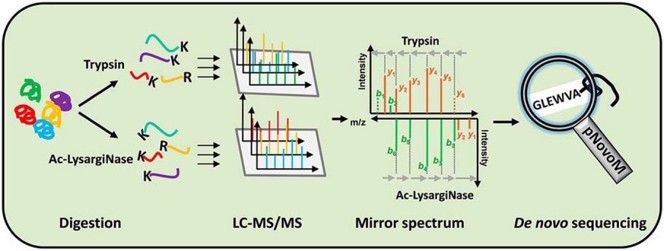Peptide De Novo Sequencing
- Home
- Services
- Peptide Sequencing
- Peptide De Novo Sequencing
Service Details
In spite of the continuously growing sequence databases, de novo sequencing of peptides, i.e. sequencing without assistance of a linear sequence database, is still essential in several analytical situations. For example, analyses of protein sequence variants or their splice isoforms require de novo sequencing, as well as protein analysis from organisms with unsequenced genomes. In addition, de novo sequencing is essential for analysis of peptides containing non-proteinic or modified amino acids, as typically present. The basic principle of de novo sequencing is to use the mass difference between two fragment ions to calculate the mass of amino acid residues on the peptide chain, among which CID and ETD are the most effective techniques for de novo peptide sequencing, both of which can generate Peptide MS/MS spectra with very high structural information, CID is best for small peptides of 1-2 kDa, while ETD can handle larger peptides.
 Fig. 1. The
process of peptide de novo sequencing by mass spectrometry. (Hao Y, et al. 2019)
Fig. 1. The
process of peptide de novo sequencing by mass spectrometry. (Hao Y, et al. 2019)
Creative Proteomics has developed a combined HCD+ETD peptide de novo sequencing method by using mass spectrometry to obtain higher energy collisional dissociation (HCD) and electron transfer dissociation (ETD) spectra of the same precursor. Our experienced scientists using the combination of HCD+ETD that it can collect more complementary fragmentation information with high resolution and high-quality accuracy to greatly improve the accuracy and speed of de novo sequencing. 86% of the top-most candidate sequences derived by our method from the HCD + ETD spectral pair matched the database search results with 95% accuracy, much higher than using only HCD (87%) or only ETD spectra (57%), the average peptide sequence extraction time is only 0.018s.
In addition, we will use a variety of proteases to digest and identify the target peptides respectively. While obtaining the fragmented peptide fragments, the splicing between the peptide fragments will complete the 100% determination of the peptide sequence, that is, by De novo sequencing method was used for the determination.
Our established peptide de novo sequencing platform has been widely chosen by our cusyomer for the following unique features.
At Creative Proteomics, we provide complete and professional peptide de novo sequencing services for global customers which was used for the discovery of new peptides and development of multifunctional peptides and complexes. Our professional scientists can also design customized services according to your requirements. Please feel free to contact us If you are interested in our services, we look forward to with your cooperation.
References
For research use only, not intended for any clinical use.